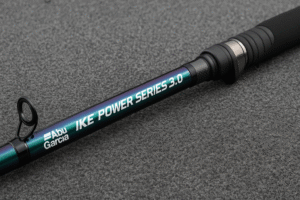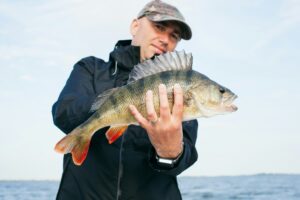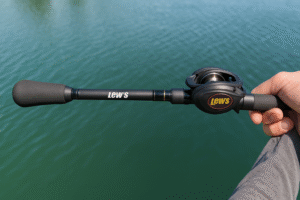How to Catch Bluegill: A Beginner’s Guide to Hooking More Fish
The fishing line tightened, and the rod tip jerked. A quick pull and a small but spirited fish surfaced, its golden scales flashing in the sun. Bluegill fishing is one of the easiest and most exciting ways to start fishing.
These fish are small but put up a fun fight, making them perfect for beginners. They’re found in ponds, lakes, and rivers across the U.S., biting on simple baits like worms and crickets. With the right gear and a few easy techniques, catching them becomes effortless. Whether fishing from the shore or a boat, bluegill fishing guarantees fun for all ages.
Best Baits and Lures for Bluegill
Catching bluegill is easy when using the right bait. These fish are always looking for their next meal, and they aren’t too picky. Whether using live bait, artificial lures, or homemade options, choosing the right one can make all the difference.
Live Baits
Live bait is one of the best ways to attract bluegill. These fish love natural food, and live bait looks, smells, and moves just like their usual meals. Some of the top choices include:
- Worms: Nightcrawlers and red wigglers are classic bluegill baits. Simply break off a small piece and hook it to keep the bait size just right.
- Crickets: These are a favorite snack for bluegill. Hook them through the back and let them float near the surface for great results.
- Waxworms: These tiny, soft worms are perfect for picky bluegill, especially in colder months when other insects are less active.
Artificial Lures
If live bait isn’t an option, artificial lures can work just as well. The key is to use small, lightweight lures that mimic bluegill’s natural food. Some top choices include:
- Small Jigs: A 1/32 or 1/16-ounce jig tipped with a soft plastic grub can be deadly for bluegill. Slowly bouncing it in the water attracts bites.
- Soft Plastics: Tiny worms, minnows, or insect-shaped plastics work great when fished under a bobber or retrieved slowly.
- Spinners: Small, inline spinners create flashes and vibrations that grab a bluegill’s attention, making them curious enough to bite.
DIY Baits
Homemade baits can be surprisingly effective. Some great options include:
- Bread Balls: Rolling small pieces of bread into tight balls can attract hungry bluegill.
- Corn Kernels: A single kernel of canned corn on a small hook can work well, especially in stocked ponds.
- Dough Baits: Mixing flour, water, and a little bit of sugar can create a sticky bait that bluegill love.
Trying different baits and lures can help find what works best in different fishing spots. Bluegill aren’t too picky, so experimenting with these options can lead to a fun and successful fishing day.
Proven Techniques to Catch More Bluegill
These fish are aggressive feeders, but knowing how to present your bait can make all the difference. Whether fishing with a bobber, targeting the bottom, or trying fly fishing, using the best technique for the situation can help land more fish.
Bobber Fishing
Bobber fishing is one of the simplest and most effective ways to catch bluegill. This method keeps the bait at the perfect depth while letting anglers know exactly when a fish bites.
How to Set Up a Bobber Rig:
- Attach a small hook (#6 to #10) to the end of your fishing line.
- Add a split shot sinker about 6 inches above the hook to keep the bait steady.
- Clip a bobber to the line, adjusting it so the bait hangs just above the bottom or near underwater plants.
- Use live bait like worms or crickets for the best results.
Once the bobber is in the water, keep an eye on it. If it moves slightly, a bluegill is nibbling. When it fully disappears or bounces around, set the hook with a quick tug.
Bottom Fishing
While bluegill are often near the surface, they sometimes stay close to the bottom, especially in deeper lakes or during hot summer days. Bottom fishing helps reach these fish when they are hiding lower in the water.
How to Fish Near the Lakebed:
- Use a small hook and a split shot weight to keep the bait on the bottom.
- Instead of a bobber, let the bait sink naturally.
- Slowly reel in or twitch the rod every few seconds to keep the bait active.
- Popular baits for bottom fishing include worms, waxworms, or small pieces of bread.
Bluegill often pick up food from the lakebed, so keeping the bait still or slowly dragging it can lead to more bites.
Fly Fishing for Bluegill
Bluegill love insects, making them a great target for this method, especially in shallow waters. This technique is perfect for small ponds, slow-moving rivers, and areas with lots of vegetation.
How to Fly Fish for Bluegill:
- Use a lightweight fly rod and a floating line.
- Choose small flies that mimic insects, such as foam spiders, poppers, or tiny nymphs.
- Cast near lily pads, under docks, or close to the shoreline.
- Let the fly sit for a few seconds, then twitch it slightly to mimic a bug struggling on the water.
Since bluegill are aggressive feeders, they often strike flies quickly. Using a slow and steady motion helps keep them interested.
Locations to Find Bluegill
Bluegill are found in many types of freshwater, but there are certain areas where they tend to gather. These fish love places with plenty of cover and food. One of the best spots to look for bluegill is near docks. The shade from the dock and the structure underneath attract bluegill looking for shelter and food.
Submerged logs and fallen trees are also prime locations. These spots provide shelter for bluegill and create a perfect hiding place from predators. As the fish swim around the logs, they find insects and smaller fish to eat.
Lily pads are another excellent spot to find bluegill. The floating pads give them shade and protection from the sun, and insects often gather around the pads. Bluegill like to feed in these areas, especially in the early morning or late afternoon when they are more active.
Weed beds, where underwater plants grow thick, are another great place to fish for bluegill. These fish love to hide in the plants and pick off small prey that swims by.
If you can find a combination of these features in one spot, you’ve found a prime location for bluegill fishing. The key is to look for areas with cover, food, and a bit of shade.
Catch and Release vs. Keeping Bluegill
It’s important to release bluegill when they’re too small or if you’re not interested in eating them. This helps keep the fish population healthy. However, if you catch a larger one and plan to eat it, it’s okay to keep it. Always follow ethical fishing practices by respecting local rules and limits. If you plan to eat them, clean the fish right away, remove the scales, and cook them by frying, grilling, or baking for the best taste.
To catch more bluegill, remember to use the right bait, whether it’s worms, crickets, or small lures. Focus on fishing near docks, submerged logs, lily pads, and weed beds, where bluegill love to hide. Try different techniques like bobber fishing or bottom fishing to find what works best for you. Most importantly, enjoy the process and be patient
Right away, don’t be afraid to get out there and start fishing. Bluegill are a great fish to begin with and offer lots of fun.
Have you caught bluegill before?





